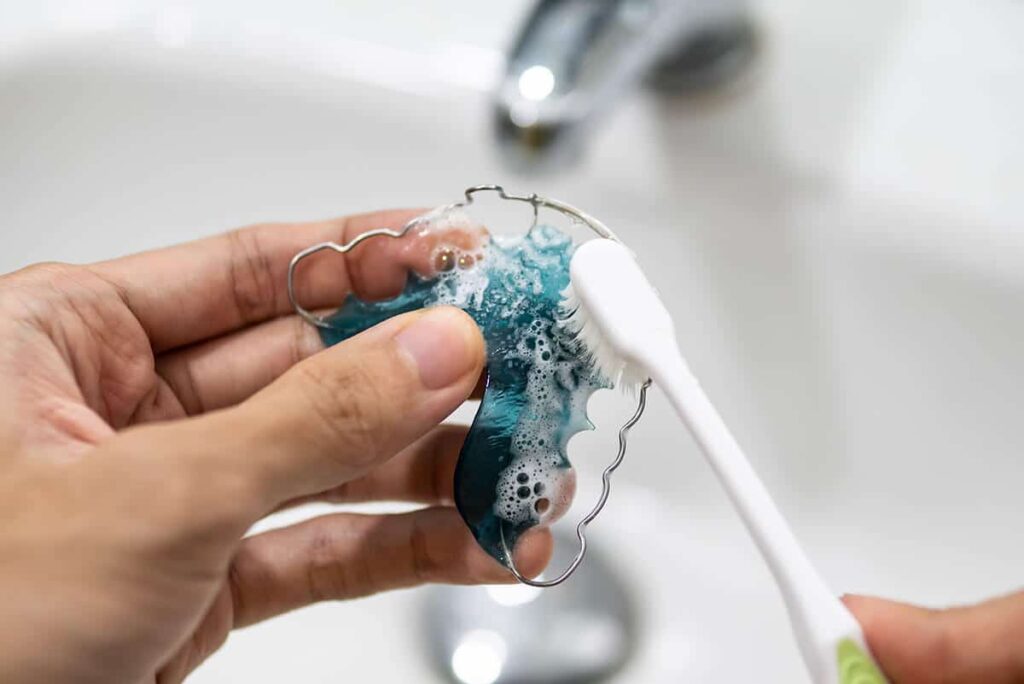
Most people would never think about skipping days’ worth of tooth brushing. Washing a retainer is crucial as a result. However, many people who wear retainers neglect to clean them for extended periods.
The same bacteria that accumulate on teeth can proliferate on a retainer. Therefore, placing an unhygienic retainer in your mouth is equivalent to putting a solution containing bacteria and plaque on your teeth and gums.
Here are six suggestions to help you ensure that your retainer is bacterial-free and spotless.
1. Water for cleaning on the go
While water alone won’t clean a retainer, consuming lots throughout the day can help stop the spread of bacteria. Maintaining a moist retainer might help shield it from harm. Water also helps prevent dry mouth, which is associated with dental deterioration.
You can swish water in their mouth several times if you feel like your retainer is unclean.
Just as soda and other sugary drinks can damage teeth, they can also damage retainers. Remember to remove your retainer before consuming any food or beverages that contain sugar.
2. Toothpaste
You should brush your retainer in addition to your teeth. The ideal combination is a non-whitening toothpaste and a toothbrush with soft bristles. After that, take out the retainer and give it a good rinse.
After removing the retainer, brush your teeth once more to remove any residue.
3. Denture cleaner
Periodically cleaning a retainer with denture cleanser is safe, especially if there’s no other way to clean it. However, with time, the yellowing of a retainer can occur due to denture cleansers.
Rinse the retainer and let it soak in the denture cleanser for around 20 minutes to clean it with denture cleaner. Use a toothbrush to scrape it gently after removing it.
Rinse the retainer until it stops tasting like denture cleanser if that is the case.
4. Baking soda
A safe, multipurpose disinfectant is baking soda. Additionally, it might help whiten yellowed retainers. Baking soda can keep a retainer from creating pH imbalances that could damage the mouth and manage bacteria without harsh chemicals.
To use baking soda, mix half baking soda and half water into a paste. For the mixture to adhere to the retainer, it must be sufficiently thick.
Afterward, you can use a soft toothbrush and the mixture to carefully clean the retainer, just like you would with toothpaste. Rinsing the retainer completely is the best way to remove residue.
5. Mouthwash
The purpose of mouthwash is to eliminate bacteria, deposits, and plaque from the mouth. If no other solutions are available, you can also clean a retainer with it.
It is not ideal and might not clean a retainer sufficiently if mouthwash is used every time. Alcohol-based mouthwash has the potential to dry up the mouth and a retainer.
If you have no other options, try giving a retainer a two to three-minute soak in non-alcoholic mouthwash, followed by a cold water rinse and a gentle brushing with a soft toothbrush.
6. Retainer cleaner
Several manufacturers provide retainer cleansers. These goods are cost-effective for anyone needing more time or motivation to create their solution.
It’s crucial to adhere to the instructions on the packaging. Some varieties call for an overnight soak or a sonic cleaning machine. Some are not meant to be used with specific kinds of retainers or if you have gum disease or sensitive teeth.
An orthodontist might be able to suggest a retainer cleaner that suits your requirements.
Conclusion
You should clean your retainer by gently brushing with a soft-bristled brush every time you brush your teeth. A more extensive cleaning should be done once a week. If you don’t want to waste time getting a new retainer, take good care of it now.


